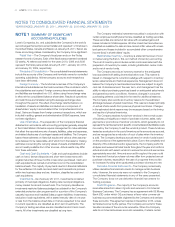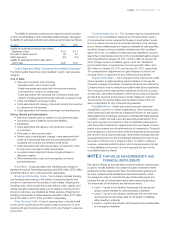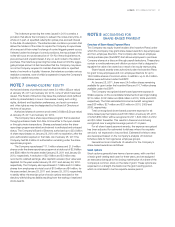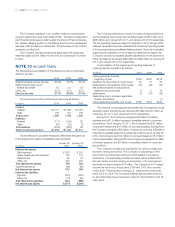Lowe's 2010 Annual Report Download - page 39
Download and view the complete annual report
Please find page 39 of the 2010 Lowe's annual report below. You can navigate through the pages in the report by either clicking on the pages listed below, or by using the keyword search tool below to find specific information within the annual report.LOWE’S 2010 ANNUAL REPORT 35
interests in those receivables, including the funding of a loss reserve
and its obligation related to GE’s ongoing servicing of the receivables
sold. Any gain or loss on the sale is determined based on the previous
carrying amounts of the transferred assets allocated at fair value between
the receivables sold and the interests retained. Fair value is based on
thepresentvalueofexpectedfuturecashows,takingintoaccount
the key assumptions of anticipated credit losses, payment rates, late
fee rates, GE’s servicing costs and the discount rate commensurate
with the uncertainty involved. Due to the short-term nature of the
receivables sold, changes to the key assumptions would not materially
impact the recorded gain or loss on the sales of receivables or the fair
value of the retained interests in the receivables.
Total commercial business accounts receivable sold to GE were
$1.7billionin2010,$1.6billionin2009and$1.7billionin2008.The
Companyrecognizedlossesof$31millioninboth2010and2009,and
$38millionin2008onthesereceivablesalesasSG&Aexpense,which
primarily relates to the fair value of the obligations incurred related to
servicing costs that are remitted to GE monthly. At January 28, 2011
and January 29, 2010, the fair value of the retained interests was
determinedbasedonthepresentvalueofexpectedfuturecashows
and was insignificant.
Sales generated through the Company’s proprietary credit cards
arenotreectedinreceivables.UnderanagreementwithGE,creditis
extendeddirectlytocustomersbyGE.Allcreditprogram-relatedservices
are performed and controlled directly by GE. The Company has the
option, but no obligation, to purchase the receivables at the end of
the agreement in December 2016. Tender costs, including amounts
associated with accepting the Company’s proprietary credit cards, are
recordedinSG&Aexpenseintheconsolidatedstatementsofearnings.
The total portfolio of receivables held by GE, including both
receivables originated by GE from the Company’s proprietary credit
cards and commercial business accounts receivable originated by the
CompanyandsoldtoGE,approximated$5.8billionatJanuary28,
2011,and$6.5billionatJanuary29,2010.
Property and Depreciation – Property is recorded at cost. Costs
associated with major additions are capitalized and depreciated.
Capitalassetsareexpectedtoyieldfuturebenetsandhaveuseful
liveswhichexceedoneyear.Thetotalcostofacapitalassetgenerally
includesallapplicablesalestaxes,deliverycosts,installationcostsand
other appropriate costs incurred by the Company, including interest in
the case of self-constructed assets. Upon disposal, the cost of
properties and related accumulated depreciation is removed from the
accounts,withgainsandlossesreectedinSG&Aexpenseonthe
consolidated statements of earnings.
Depreciation is provided over the estimated useful lives of the
depreciable assets. Assets are depreciated using the straight-line method.
Leasehold improvements and assets under capital lease are depreciated
over the shorter of their estimated useful lives or the term of the related
lease, which may include one or more option renewal periods where
failuretoexercisesuchoptionswouldresultinaneconomicpenaltyin
such amount that renewal appears, at the inception of the lease, to be
reasonably assured. During the term of a lease, if leasehold improve-
ments are placed in service significantly after the inception of the lease,
the Company depreciates these leasehold improvements over the
shorter of the useful life of the leasehold assets or a term that includes
lease renewal periods deemed to be reasonably assured at the time
the leasehold improvements are placed into service. The amortization
oftheseassetsisincludedindepreciationexpenseontheconsolidated
financial statements.
Long-LivedAssetImpairment/ExitActivities – The carrying
amounts of long-lived assets are reviewed whenever certain events or
changes in circumstances indicate that the carrying amounts may not
be recoverable.
Long-lived assets held-for-use includes operating stores as well
asexcessproperties,suchasrelocatedstores,closedstoresand
other properties that do not meet the held-for-sale criteria. A potential
impairment has occurred for long-lived assets held-for-use if projected
futureundiscountedcashowsexpectedtoresultfromtheuseand
eventual disposition of the assets are less than the carrying amounts
of the assets. An impairment loss is recorded for long-lived assets
held-for-use when the carrying amount of the asset is not recoverable
andexceedsitsfairvalue.
Excesspropertiesthatareexpectedtobesoldwithinthenext
12 months and meet the other relevant held-for-sale criteria are classi-
fied as long-lived assets held-for-sale. An impairment loss is recorded
for long-lived assets held-for-sale when the carrying amount of the
assetexceedsitsfairvaluelesscosttosell.Along-livedassetisnot
depreciated while it is classified as held-for-sale.
For long-lived assets to be abandoned, the Company considers
the asset to be disposed of when it ceases to be used. Until it ceases
to be used, the Company continues to classify the asset as held-for-use
and tests for potential impairment accordingly. If the Company commits
to a plan to abandon a long-lived asset before the end of its previously
estimated useful life, its depreciable life is re-evaluated.
ImpairmentlossesareincludedinSG&Aexpense.TheCompany
recordedlong-livedassetimpairmentlossesof$71millionduring2010,
including$36millionforoperatingstores,$26millionforexcess
propertiesclassiedasheld-for-useand$9million,includingcoststo
sell,forexcesspropertiesclassiedasheld-for-sale.TheCompany
recordedlong-livedassetimpairmentlossesof$114millionduring
2009,including$53millionforoperatingstores,$40millionforexcess
propertiesclassiedasheld-for-useand$21million,includingcosts
tosell,forexcesspropertiesclassiedasheld-for-sale.TheCompany
recordedlong-livedassetimpairmentlossesof$21millionduring
2008,including$16millionforoperatingstoresand$5millionfor
excesspropertiesclassiedasheld-for-use.
Thenetcarryingamountofexcesspropertiesthatdonotmeet
the held-for-sale criteria is included in other assets (non-current) on the
consolidatedbalancesheetsandtotaled$239millionand$205million
at January 28, 2011 and January 29, 2010, respectively.
When locations under operating leases are closed, a liability is
recognized for the fair value of future contractual obligations, including
futureminimumleasepayments,propertytaxes,utilitiesandcommon
area maintenance, net of estimated sublease income. Amounts accrued
were not material for any of the periods presented.
Leases – For lease agreements that provide for escalating rent
payments or free-rent occupancy periods, the Company recognizes
rentexpenseonastraight-linebasisoverthenon-cancelablelease
termandoptionrenewalperiodswherefailuretoexercisesuchoptions
would result in an economic penalty in such amount that renewal
appears, at the inception of the lease, to be reasonably assured. The
lease term commences on the date that the Company takes possession
of or controls the physical use of the property. Deferred rent is included
in other liabilities (non-current) on the consolidated balance sheets.
























